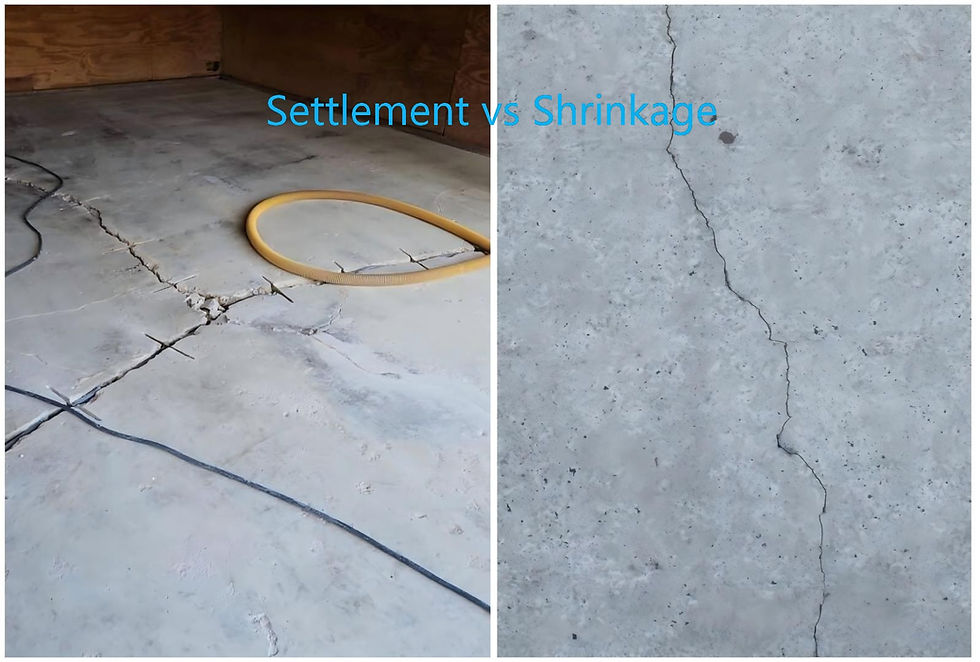Why Concrete Cracks: Understanding Plastic Shrinkage
- Jason
- 1 day ago
- 3 min read
Suitable for architectural engineers, structural engineers, flooring contractors, precast component manufacturers, and technicians.

Concrete cracking at early age remains one of the most common—and most misunderstood—problems in construction. Even when mix design, curing, and finishing are well controlled, many slabs, pavements, and industrial floors still develop early-age surface cracks. The primary cause is plastic shrinkage, a rapid moisture-loss phenomenon that occurs within the first few hours after placement.
Micro synthetic fibers—especially micro polypropylene fibers—are among the most effective solutions for preventing plastic shrinkage cracking. They form a distributed reinforcement network that stabilizes the fresh concrete matrix before initial set, reducing crack width and frequency. Before understanding how fibers work, it is essential to understand what plastic shrinkage is and why traditional reinforcement cannot stop it.
What Is Plastic Shrinkage?
Plastic shrinkage refers to cracking that appears before concrete hardens, typically 30 minutes–6 hours after placement. These cracks form when the evaporation rate of water at the surface exceeds the bleeding rate of the concrete.
When water evaporates faster than it rises to the surface, capillary tension builds inside the matrix, causing the still-plastic concrete to pull apart. This leads to characteristic short, irregular, spider-web patterns across slabs, pavements, and large exposed surfaces.
Evaporation Rate vs Bleeding Rate
Evaporation rate is driven by weather conditions:
High wind speed
Low relative humidity
High air temperature
High concrete temperature
When evaporation exceeds 0.5 kg/m²/hr, the risk of plastic shrinkage cracks increases dramatically. If evaporation reaches 1.0 kg/m²/hr, cracking is almost guaranteed unless protective measures are taken.
Bleeding rate depends on mix design:
Low water-cement ratio
High fines / cementitious materials (slag, silica fume)
Smaller aggregates
SCC and high-performance mixes
These modern mix designs reduce bleeding, making concrete much more vulnerable.
Hot Weather Consideration
In hot weather (≥ 30–35°C), the surface dries extremely fast. Even with curing compounds, cracking may still occur because:
Bleed water evaporates instantly
Wind accelerates surface moisture loss
Low humidity increases vapor pressure
This is why hot-weather concreting requires wind breaks, fogging, curing blankets, or micro synthetic fibers.

Main Causes of Early-Age Cracks
Plastic shrinkage cracking is a weather-driven process, and three key environmental factors accelerate moisture loss.
Wind
Wind increases evaporation exponentially. Even a moderate 10–15 km/h wind can double the evaporation rate.
High Temperature
High air or concrete temperature accelerates:
Water evaporation
Cement hydration
Set time
This combination creates high shrinkage stress before the concrete gains tensile strength.
Low Humidity
Low relative humidity (< 40%) causes rapid capillary water loss. Large exposed slabs dry unevenly, producing differential shrinkage and surface tension cracks.

Why Traditional Reinforcement Cannot Prevent Plastic Shrinkage Cracks
Steel reinforcement, mesh, and rebar are essential for structural load capacity—but they cannot prevent plastic shrinkage cracking, because early-age cracks develop before concrete hardens.
Two technical reasons explain this.
Mesh Location Issue
Wire mesh is typically placed:
In the lower third of the slab (due to chairs or foot traffic displacement)
Plastic shrinkage cracks occur at the surface, so mesh is positioned far below the cracking plane. It cannot provide restraint where the cracks form.
Timing Mismatch
Plastic shrinkage cracks occur:
Before initial set
Within the first 2–6 hours
Traditional reinforcement becomes effective only after concrete hardens and bonds to steel. Thus, reinforcement is inactive when plastic shrinkage occurs.

How Micro Fibers Prevent Early-Age Cracking
Micro synthetic fibers—especially micro polypropylene fibers—are highly effective in mitigating plastic shrinkage because they work in the fresh concrete phase, when traditional steel cannot.
Distributed Reinforcement
Micro fibers disperse throughout the concrete, forming a 3D micro-reinforcement system. Benefits include:
Reduced capillary stress
Improved plastic cohesion
Better crack resistance
Enhanced surface durability
Fibers control micro-cracks before they grow into visible cracks.
Crack Reduction Tests
ASTM C1579 and various international studies show:
40–80% reduction in crack area
50–90% reduction in maximum crack width
More uniform hydration and reduced settlement cracking
Micro PP fibers are now a standard solution for industrial floors, pavements, precast, mortar, screed, and shotcrete applications.
Learn more about HPM® PP polypropylene microfiber
See all micro synthetic fiber types
Compare with macro synthetic fibers





Comments